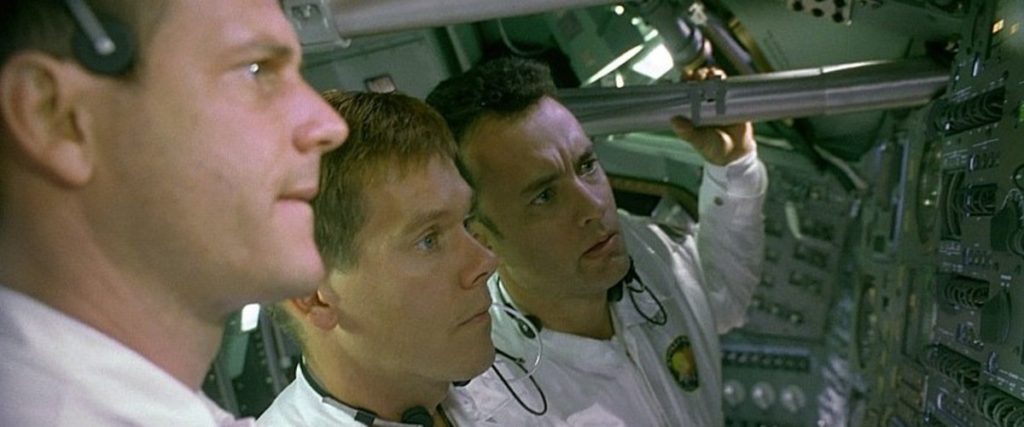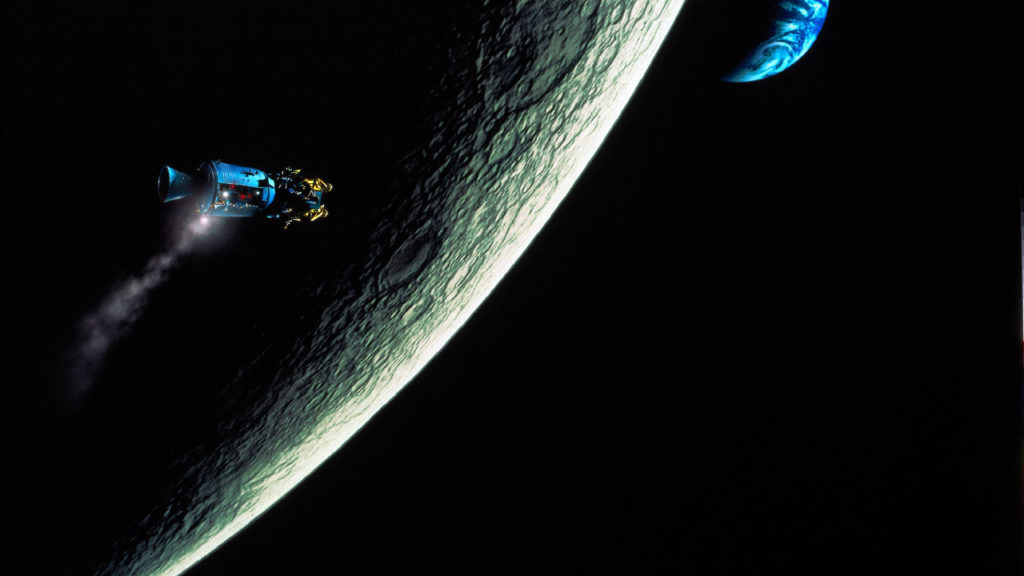Apollo 13 (1995)
CAST: Tom Hanks, Bill Paxton, Kevin Bacon, Gary Sinise, Ed Harris, Kathleen Quinlan
For those old enough to have watched the April 1970 Apollo 13 crisis unfold live on television, Ron Howard’s Apollo 13 may bring back strong memories. For those who did not experience it at the time, it may serve as a fascinating history lesson. For everyone else, it’s a well-constructed docudrama, and a tribute to what one character refers to as NASA’s finest hour.
First announced by President John F. Kennedy in 1961, the Apollo program came to a climax on July 20, 1969, when Neil Armstrong stepped out of Apollo 11’s lunar module and took his iconic “one small step for man, one giant leap for mankind”. It was not only a moment of achievement for mankind, but also of immense national pride; after years of playing catch-up with the Soviet Union in the “space race”, we’d beaten the Russians to the moon. Nine months later, the Apollo 13 mission, made up of Jim Lovell (Tom Hanks), Fred Haise (Bill Paxton), and Jack Swigert (Kevin Bacon), was slated to take us back there. It’s regarded as a “routine” mission, and despite Lovell’s insistence that “nothing about going to the moon is routine”, this kind of thing was now regarded as so “been there, done that” that the three networks didn’t even air Lovell’s first broadcast to Earth. However, when an oxygen tank explosion leaves the crew with a dwindling oxygen supply and failing power, the news was suddenly riveted, as was the entire world. Meanwhile, NASA scrambles to brainstorm ways to bring the three men home alive.
Perhaps the biggest, and arguably most difficult, accomplishment of Apollo 13 is that it reaches and sustains a level of tension despite the outcome being well-known. Lovell, Haise, and Swigert are faced with oxygen deprivation, carbon monoxide poisoning, and/or freezing to death, and they have to reenter the atmosphere at precisely the right angle; too steep and they’ll be incinerated, too shallow and they’ll ricochet off the top of the atmosphere like a rock skipping on a pond and be sent careening back out into space. And running desperately low on power, they have to orient themselves without their instrumentation and with the naked eye, by aligning their view of Earth outside the viewport window. Meanwhile, back at mission control, NASA’s control room is a bustling hive of controlled chaos, as Gene Kranz (Ed Harris) stoically oversees an entourage of frantic subordinates scrambling to and fro, brainstorming various possibilities, some more feasible than others, for saving the three astronauts. “We are not losing these men on my watch”, Kranz declares with an unflappable authority that makes you almost believe it, but his—and everyone else’s—increasingly stressed-out expressions drives home how close they all knew they were coming to being unable to make good on that vow.
Ron Howard’s direction is to-the-point and no-nonsense, dispensing with the cornball superfluous subplots lesser versions of this kind of movie feel the need to muddy the waters with, simply chronicling the events with rigorous historical accuracy (the script was based largely on Lovell’s own account, and co-written by retired astronaut Al Reinert, who wrote the 1989 documentary “For All Mankind”) and letting them speak for themselves, without overdramatic embellishments. There is no “villain”—or even any negative character—nor is one needed, except for mechanical failure and the cold void of space.The movie’s single-minded focus and meticulous attention to details is compelling and fascinating. Period details are impeccable, from the cars to wardrobes and hairstyles, to little details like people casually smoking at their desks. For the most part, the visual effects (relying heavily on sets and model work) are effective, and there are eye-catching moments like Haise’s tape recorder floating through the cabin, blaring a Hank Williams song (the weightlessness was created by placing the actors inside a descending airplane). At one point early on, while giving a Congressman and an entourage of reporters a guided tour of the Kennedy Space Center, Lovell brags that they now have a computer “that fits in one room and can send out millions of instructions”. It’s moments like these that make us realize these men went into space and touched the moon with technology that seems archaic and primitive by today’s standards, and may also make us feel that we’ve lost a little of the daring and resourcefulness that made them achieve it anyway. Apollo 13 is a throwback to a less cynical time, when “can do” optimism still prevailed. The strong sense of verisimilitude is amplified by regularly incorporating snippets of the actual 1970 news reports, many of which feature Walter Cronkite.
There is also a little interpersonal tension among the three leads; originally, the Apollo 13 crew is slated to consist of Lovell, Haise, and Ken Mattingly (Gary Sinise). Lovell, Haise, and Mattingly are a well-oiled machine that’s worked together long enough that they can practically read each other’s minds, and Lovell and Haise are less-than-thrilled when Mattingly is replaced (due to exposure to measles, which he never actually contracts) with Jack Swigert, a hotshot ladies’ man who’s a fine pilot but an inexperienced astronaut. When the key explosion happens on Swigert’s watch, the cabin tension eventually boils over into Haise pointing fingers (although the later investigation determined the culprit was faulty wiring, not human error). Lovell shuts the infighting down with no-nonsense pragmatism: “We’re not gonna bounce off the walls for ten minutes and end up facing the exact same problems!”. And at another point, it is Swigert, whose competence the others had harbored doubts about, who foresees a problem which Lovell and Haise had overlooked. There is also a scene, which toes the line between poignant and cheesy, where Lovell (who has dreamed of following in Neil Armstrong’s footsteps and walking on the moon for the past nine months) zones out into a fantasy of stepping down from the lunar module onto the moon surface and fulfilling his dream, then snapping back to reality and seeing the moon’s ghostly white surface passing by outside his window, his life’s dream so close, yet out of his grasp. Meanwhile back on Earth, Mattingly sulks despondently around his hotel room, having also had his dream snatched away from him, but when the crisis occurs, he snaps into action and plays a crucial role in bringing his colleagues home, shutting himself away in the mock-up lunar module at Kennedy Space Center, set to the exact conditions the men in space are experiencing, and tirelessly running through simulation after simulation to help the technicians work out a viable solution (“they don’t get a break, I don’t get a break” he replies when urged to get some rest). As Apollo 13 conveys clearly, there was no single “hero” of the Apollo 13 rescue, but a large ensemble of ingenious and resourceful (but not infallible) people working tirelessly, both in space and on Earth, to prevent disaster. And there is a third viewpoint, of the loved ones crowded anxiously around the TVs in their living rooms, principally Lovell’s wife Marilyn (Kathleen Quinlan), waiting desperately for good news.
 With its single-minded focus on the hows and whys of the mission, Apollo 13 isn’t long on character development, but the ensemble cast is uniformly solid and avoids melodramatic histrionics. Tom Hanks might be the ostensible lead, but he, Bill Paxton, and Kevin Bacon play effectively off each other as a trio without anyone crowding the spotlight. Ed Harris plays the stressed-out mission controller Gene Kranz with a stoic authority that only occasionally gives way to a burst of anger. Many actors have played the archetype of the “NASA mission controller staring intensely at monitors”, but Harris’ Kranz is pretty much the original template, with Loren Dean, Brett Cullen, Xander Berkeley, Chris Ellis, and Ray McKinnon filling out his entourage of assorted subordinates and colleagues. As in many of his films, Ron Howard’s brother Clint Howard has a supporting role, and their father Rance Howard has a cameo.
With its single-minded focus on the hows and whys of the mission, Apollo 13 isn’t long on character development, but the ensemble cast is uniformly solid and avoids melodramatic histrionics. Tom Hanks might be the ostensible lead, but he, Bill Paxton, and Kevin Bacon play effectively off each other as a trio without anyone crowding the spotlight. Ed Harris plays the stressed-out mission controller Gene Kranz with a stoic authority that only occasionally gives way to a burst of anger. Many actors have played the archetype of the “NASA mission controller staring intensely at monitors”, but Harris’ Kranz is pretty much the original template, with Loren Dean, Brett Cullen, Xander Berkeley, Chris Ellis, and Ray McKinnon filling out his entourage of assorted subordinates and colleagues. As in many of his films, Ron Howard’s brother Clint Howard has a supporting role, and their father Rance Howard has a cameo.
Apollo 13 proves you don’t need the sci-fi action of Star Wars or Star Trek, or overdramatic cinematic embellishments to tell a riveting true story. Deft filmmaking, single-minded focus, and meticulous technical detail combine to make Apollo 13 a definitive docudrama depiction of “NASA’s finest hour” that came so close to being one of its worst.
* * *
